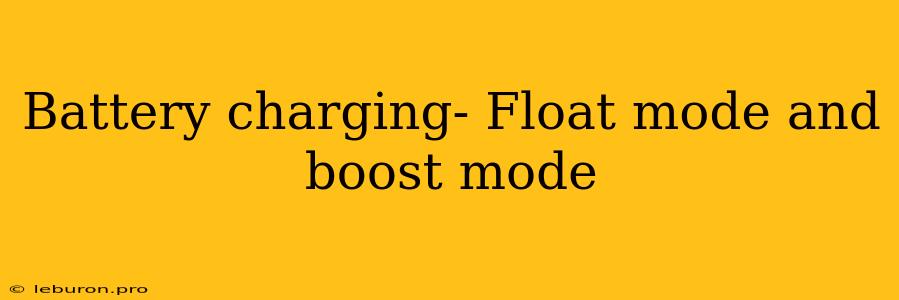Battery charging is a complex process that involves a series of stages to ensure optimal performance and lifespan. Two crucial modes within this process are float mode and boost mode, which play distinct roles in maintaining battery health. While both modes aim to keep the battery charged, they operate differently, each contributing to the overall charging cycle. Understanding these modes is essential for maximizing battery longevity and ensuring reliable power delivery. This article will delve into the intricacies of float mode and boost mode in battery charging, shedding light on their mechanisms and how they contribute to a battery's overall health.
Float Mode: Maintaining the Battery's Equilibrium
Float mode is a crucial stage in battery charging, often the final stage, where the battery is considered fully charged and maintained at a consistent level. In this mode, a low trickle charge is applied to the battery, preventing it from discharging and ensuring it remains at a stable state. The float mode current is typically very low, often just a few milliamps, and is designed to offset the natural self-discharge of the battery over time.
Float mode is essential for maintaining the battery's health and extending its lifespan. Here's why:
Preventing Overcharging and Degradation:
- Float mode prevents overcharging, which can significantly damage the battery. By maintaining a low trickle charge, it ensures the battery remains fully charged without exceeding its capacity.
- Overcharging can lead to electrolyte breakdown, electrode corrosion, and ultimately, reduced battery capacity and premature failure.
Maintaining Consistent Voltage:
- Float mode helps maintain a stable voltage level in the battery. This is crucial for applications like emergency power systems and UPS (Uninterruptible Power Supply) where consistent voltage is critical for uninterrupted operation.
Optimizing Battery Life:
- Float mode is particularly important for lead-acid batteries, which are commonly used in cars, motorcycles, and industrial applications. It helps to prevent sulfation, a process that reduces battery capacity and can lead to premature failure.
Float Mode in Different Battery Types:
- While float mode is prevalent in lead-acid batteries, it's also used in other battery types, such as lithium-ion batteries. However, the charging parameters and voltage levels may differ depending on the battery chemistry.
Boost Mode: A Quick Charge for Peak Performance
Boost mode is a stage in the battery charging process that focuses on rapidly charging the battery to a high state of charge. Unlike float mode, which emphasizes maintaining a consistent charge, boost mode aims to quickly deliver a significant amount of energy to the battery.
Boost mode is often employed in situations where a fast charge is required, such as:
Fast Charging Applications:
- Boost mode is commonly used in electric vehicles, where a quick charge is essential for extended driving range.
- It's also used in portable electronic devices like smartphones and laptops, allowing for faster charging times.
Boost Mode and Battery Health:
- While boost mode can be beneficial for fast charging, it can also put stress on the battery.
- Excessive use of boost mode can lead to increased internal heat, accelerating battery degradation.
Boost Mode Parameters:
- The charging parameters, such as voltage and current, in boost mode are typically higher than in float mode. These higher values allow for a faster charging rate.
Balancing Float Mode and Boost Mode for Optimal Battery Performance
Optimizing battery performance requires striking a balance between float mode and boost mode. While boost mode provides fast charging, it's important to limit its use to minimize stress on the battery. Conversely, float mode ensures long-term battery health and stability, but it's not ideal for rapid charging needs.
Smart Charging Strategies:
- Modern battery management systems employ smart charging strategies that dynamically adjust the charging mode based on battery state and usage patterns. This ensures optimal battery performance while minimizing wear and tear.
- These systems can intelligently switch between float mode and boost mode to achieve the best balance between fast charging and battery longevity.
Conclusion: Understanding the Importance of Float Mode and Boost Mode
Float mode and boost mode are crucial components of battery charging, each contributing to the overall health and performance of the battery. While float mode ensures long-term stability and prevents overcharging, boost mode facilitates rapid charging for specific applications. By understanding the roles of these modes and implementing smart charging strategies, users can maximize battery life and minimize degradation, ensuring reliable power delivery and a longer lifespan for their batteries.
